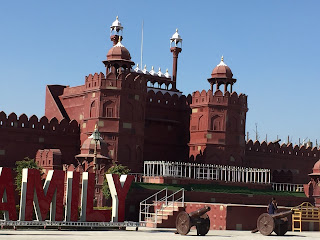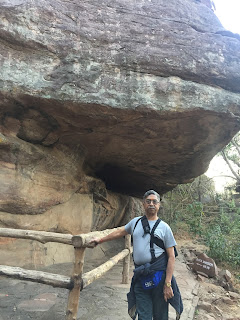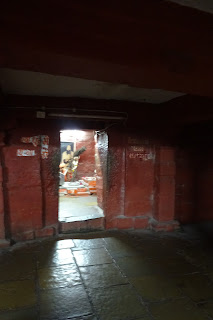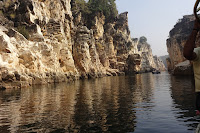On the first day of
our stay at Bhopal, we decided to see the important places within Bhopal and
use the last day to visit Bhimbedka and other sites outside Bhopal.
Our first stop was at
Taj-aul-masjid, one of the three largest masjids in the world, the construction
of which started in 1887 during the time of Nawab Shah Jahan Begum.
 |
| Taj-aul masjid |
 |
| Taj-aul masjid |
From there, we went
to Hanuman Tekre, a small hillock on top of which a beautiful Jain temple had
been built. One could either drive the car all the way to the top of the hill
or use the rope car. We used the latter.
From Hanuman Tekre,
we took a public bus to People’s Mall, probably one of the latest entertainment
centres in Bhopal. For a small entry fee of Rs.50 one could spend the whole day
here. We were quite impressed about the mall, with its exquisite entrance hall,
multiplex theatres, various miniature replica of several important structures
from all over the world – Taj Mahal, Red Fort, Eiffel Tower, British
Parliament, Statue of Liberty, and so on. The accompanying pictures will speak
it all, no need to describe them.
It looked as though the entire mall is constantly under development. Please remember, it is not a mall for shopping.
From People’s Mall,
we took another bus to the famous Birla Mandir. On the way, we were caught in a
terrible traffic jam which lasted for more than 2 hours around the areas closer
to the railway station, Hamidia Road, Nadra Bus Stand. And these areas form the
border of the old and new Bhopal. Eventually, we learnt that traffic jam was a
regular feature in Bhopal in these areas. Hardly any police was there to solve
the problem. There was complete chaos and ‘free for all’ traffic. I also
noticed that in such a sensitive place with several side roads, junctions,
markets and shops on either side there were very few traffic signals to
regulate the traffic. The behavior of the public, driving cars and two wheelers
compounded the problems, for the most part.
As it got very late
after visiting the Lakshmi Narain Temple we were mentally tired and so returned
back to the hotel hoping that we would be visiting the two important ‘talab’s
(lakes) the next day, which, unfortunately, didn’t happen.
On the last day of
our trip to Madhya Pradesh, we had arranged for a taxi to take us from Bhopal to
Sanchi, Udaigiri Caves, Bhojpur Shiva Temple, and Bhimbedka Rock Shelters. All
these places were stunningly beautiful in their own way.
Sanchi Stupa belongs
to the 3rd century, commissioned by the Emperor Asoka.
Udaigiri rock caves
represent some of the oldest surviving rock caves, belonging the Gupta period
of 5th century CE.
In Bhojpur, the
Bhojeswar Temple dedicated to Lord Siva belongs to 11th century. The
temple commissioned by the King Bhoja is incomplete and houses the 18 feet tall
Shivling. The temple, its location in a vast expanse of open area, and Shivling
were very impressive. A lot of tourists and devotees were seen in and around
the temple.
At a short distance from the Bhojeswar Temple there is another
historic Jain temple.
As we were in a hurry
to reach Bhibedka before it got dark we didn’t visit the Parvathy cave and
remains of Bhoja’s royal palace.
When we reached
Bhimbedka, it was past 4 pm. In fact, the urge in me to visit Bhimbedka rock
shelters only culminated in our visit to Madhya Pradesh. I had read on the
internet that these rock shelters belong to the ‘paleolithic’, ‘mesolithic’ and
‘historic’ periods. They exhibit the earliest traces of human habitation in the
Indian Subcontinent. Containing more than 750 rock shelters spread over 10
kilometers there are evidences that they were home to the ‘homo erectus’ some
100000 years ago. On some of these rock shelters there are cave paintings which
are at least 30000 years old. These paintings represent themes like animals,
early hunting, and dancing.
As you enter the area
you will find yourselves in the ‘auditorium’ cave, a significant structure, and
the largest one. We walked through quickly some 12 rock shelters of different
shapes and sizes.
I felt that probably
we should have come to Bhimbedka Rock Shelters first and reversed our route - Bhopal
to Bhimbedka to Bhojpur to Udaigiri to Sanchi and then back to Bhopal.
We boarded a late
night train – Hazrat Nizamudeen to Chennai Duranto - which came a full 4 hours
late due to delayed start from Nizamudeen on account of fog in Delhi. We whiled
away our time in the Upper Class Waiting Room in the railway station in the
meanwhile.
Await my concluding remarks tomorrow.





























































